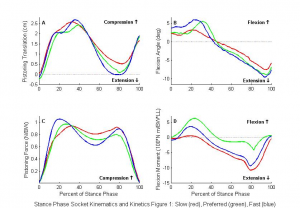Musculoskeletal Modeling and Simulation of Symmetric and Asymmetric Walking
Musculoskeletal Modeling and Simulation of Symmetric and Asymmetric Walking
Project Leads: Anna Patterson, Megan Shepherd
*ASB 2015: Example of previous musculoskeletal modeling results that have been published (LaPre 2017 Int J Num Meth, LaPre 2018 ICORR) and has a publication in process.
Able-bodied individuals walk symmetrically but some people with structural (e.g., amputation) or neurological (e.g., stroke) asymmetry walk with asymmetric gait mechanics. We are interested in how asymmetric gait patterns are controlled and what objectives dictate preferred patterns. We are performing in-silico experiments to track experimental data and predict gait mechanics based on different optimality criteria such as muscle effort and joint loading. Symmetric and asymmetric walking data of people with and without amputation is being collected in the Human Motion Analysis Laboratory at ECU. We are utilizing static optimization within OpenSim to estimate muscle activation and forces with the objective of minimizing muscle effort. For our predictive simulation and modeling, OpenSim Moco is being used to perform optimal control simulations that predict movement patterns while minimizing different criteria. We are constraining the model to walk with symmetric and asymmetric patterns while minimizing muscle effort, joint loading and combined objectives of muscle effort and joint loading. The final aspect of this initial project is to have able-bodied individuals walk with the predicted motions to understand the differences in energy expenditure and joint loading between model predictions and humans. We will use this information to improve our modeling and simulation techniques so we can inform rehabilitation programs and better understand why people walk the way they do post-injury.
Presented Work
- Patterson & Zarama 2021 NCPTA Muscle Contributions For Gait Asymmetry In Able-Bodied Participants
- Abstract
- poster
